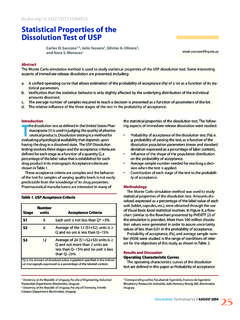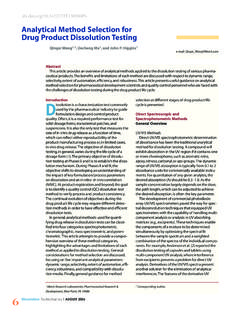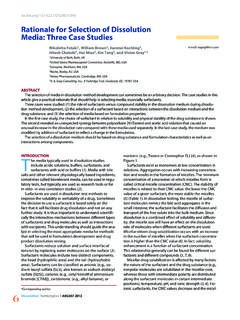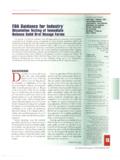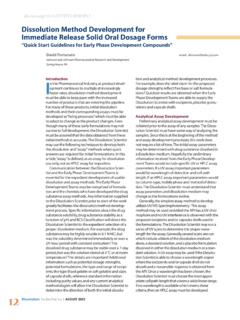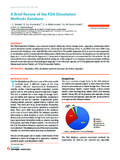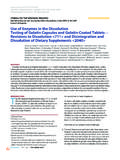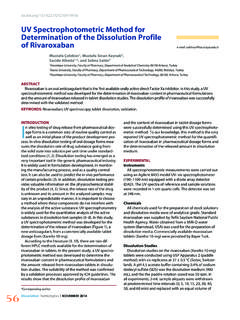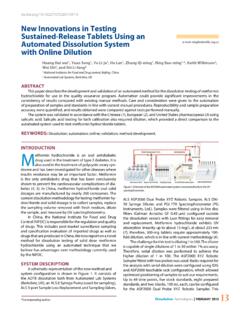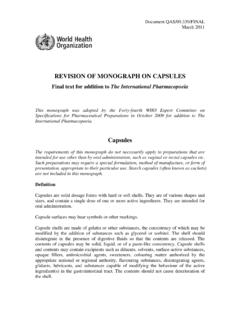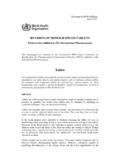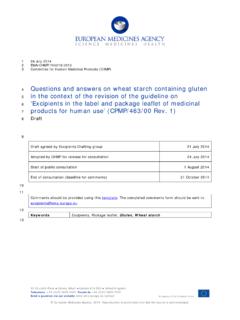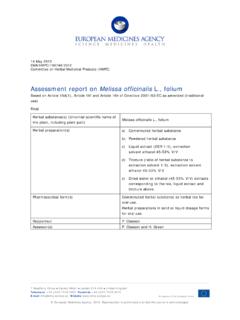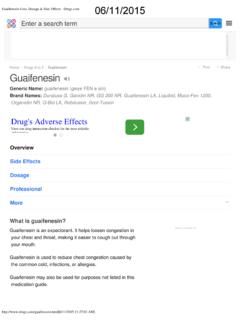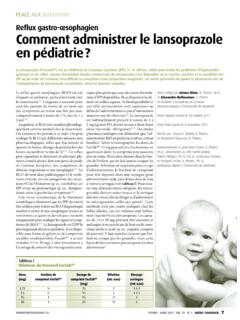Transcription of Comparison of the Rupture and Disintegration …
1 Dissolution Technologies | FEBRUARY 201121e-mail: of the Rupture and Disintegration tests for Soft-Shell CapsulesMay Almukainzi1, Mahnor Salehi1, Nadia A. B. Chacra2, and Raimar L benberg1,*1 Faculty of Pharmacy & Pharmaceutical Science, University of Alberta, 1123A Dentistry/Pharmacy Centre, Edmonton, Alberta, Canada2 Department of Pharmaceutical Science, University of Sao Paulo, BrazilABSTRACTThe USP General Chapter <2040> Disintegration and Dissolution of Dietary Supplements introduced a Rupture test as a performance test of soft-shell capsules. Traditionally, the Disintegration test was used for determining the Disintegration time of all solid oral dosage forms. The aim of this investigation was to investigate differences between the Rupture test and the Disintegration test using soft-shell capsules.
2 Five different soft-shell capsule products were chosen based on their filling contents and treated to simulate a production deficiency. The study design compared capsules as received with capsules that were treated by coating them with the liquid contents of another capsule . The capsules were incubated at room temperature and at 40 C. The tests were repeated after two weeks, and at each time point, twelve capsules of each product were tested using the Rupture and the Disintegration tests . Six capsules were tested untreated, while the other six capsules were treated. Rupture and Disintegration times were recorded as dependent variables in each experiment. The data were analyzed using to the USP definition for Disintegration , the Rupture of a soft-shell capsule can be seen as fulfilling the Disintegration criterion if the capsule contents is a semisolid or liquid.
3 Statistical analysis showed no advantage of the Rupture test over the Disintegration test. On a product-by-product basis, both tests were sensitive to certain investigated parameters. A noticeable difference between both tests was that in most cases, the Rupture test reached the defined endpoint faster than the Disintegration capsules that are subject to a Quality by Design approach should be tested with both methods to determine which performance test is the most appropriate test for a specific by Design (QbD) is a scientific approach that uses statistical methods for product design, quality testing (1), and predicting product performance from early product development to final product release (2). QbD is highly dependent on the appropriateness of test methods used and can only be successfully applied if a test is sensitive to the parameter that is performance testing of soft-shell capsules is rather a challenge because the contents of soft-shell capsules can vary from solids to liquids (3).
4 Dissolution methods used for solid oral dosage forms might not be appropriate for soft-shell capsules that have liquid or semisolid contents (4).USP General Chapter <701> Disintegration describes the procedure to evaluate Disintegration of oral dosage forms (5). The requirements of Disintegration are met if all test units disintegrate or if not more than two units out of a total of 18 units fail to disintegrate within a predetermined time General Chapter <2040> Disintegration and Dissolution of Dietary Supplements uses a Rupture test as performance test of soft-shell capsules (6). In 2002 the Rupture test was first published in Pharmacopeial Previews (7), then forwarded to USP s In-Process Revision (8), and in 2007 it was finally published in USP 30 NF 25.
5 USP 32 lists 14 monographs that use the Rupture test performed in dissolution Apparatus 2 (paddle) operated at 50 rpm with 500 mL of water as the immersion medium. The test requirements are met if all capsules Rupture within 15 min or if not more than 2 of the total of 18 capsules tested Rupture in more than 15 but not more than 30 min. For any other oral dietary supplement dosage form, Disintegration test Apparatus A or B is used if the monograph requires difference is that for hard-shell capsules, Chapter <2040> lists USP pH buffer as the immersion medium while Chapter <701> lists water as the default medium if a monograph does not specify any other medium (Figure 1) (9). USP Chapter <2040> also lists Apparatus B, which is intended for dosage forms greater than 18 mm in diameter.
6 Currently there are no scientific data available that compare the performance of the Rupture test with that of the Disintegration test. The aim of this study was to evaluate if there are advantages in using the Rupture test over the Disintegration test. A series of experiments was performed and statistical analysis was used to determine differences between the 212/25/2011 5:48:44 PM2/25/2011 5:48:44 Technologies | FEBRUARY 201122 METHODFive different soft-shell capsules were received from Banner Pharmacaps: amantadine HCl (lot No. 27060261XP), flaxseed oil (lot No. 203491-01), ginseng 100 mg (lot ), pseudoephedrine HCl (lot ), and soybean oil (lot No. XPM0309004). These capsules were chosen based on their filling contents.
7 Flaxseed oil, ginseng, and soybean oil are filled with an oil base, and pseudoephedrine capsules are filled with a water-miscible solution. Amantadine capsules contain a suspension. The study design compared the products as received with capsules that were treated by coating them with the liquid contents of another capsule to simulate a production deficiency. This was done by pouring the liquid contents of one capsule over the remaining capsules in a 120-mL plastic bottle. The bottle was tumbled at 50 rpm for 30 min. Then the bottle was stored until the next experiment was performed according to the testing capsules were incubated at room temperature and 40 C, and the tests were repeated after two weeks. At each time point, twelve capsules of each product were tested using the Rupture and the Disintegration tests .
8 A disinte-gration tester (model ED-2L, Electrolab, Betatek Ontario) consisted of two stations; each was equipped with a basket assembly as described in USP Chapter <701>. The beaker had a nominal volume of 1,000 mLwith an inside diameter of 101 1 mm (SOTAX) and was filled with about 750 mL of immersion medium to comply with the USP requirement not to submerge the basket assembly totally at any time point. All tests were performed without disks. The Rupture test was performed in 500 mL of water at 37 C and 50 rpm using USP dissolution Apparatus 2 Model 7020 (Varian, Inc.). Six capsules were tested untreated, while the other six capsules were from the treated batch. This was done to compare the sensitivity of the Rupture and Disintegration tests for detecting possible production errors during the manufacturing process.
9 The uncoated capsules represent a correct batch, while the coated capsules represent a batch with a production deficiency. The Rupture time for each unit was recorded when visible leakage of the contents was shown. The criterion of the Disintegration test was that the contents must be released from the capsule shells, and then the Disintegration time was recorded. In each experiment, the time was recorded as a dependent variable. The analysis of variance (ANOVA) was performed to compare the Rupture and Disintegration mean times for each capsule and storage condition (p = ) using Minitab 15 software. RESULTSThe mean and standard deviations from all conditions and capsules are shown in Table 1. The variability for the Rupture and Disintegration times for all capsules and test conditions are presented in Figure 2.
10 The analysis of variance (ANOVA) was performed to compare the recorded mean times for the Disintegration and Rupture tests for all capsules and conditions. The p-values are indicated in Table Soft-Shell CapsulesAmantadine capsules showed the highest variability among all capsule products for the Rupture test (Figure 2a). For this product, the shortest recorded Disintegration and Rupture times were and min, respectively. Differences between the uncoated and coated conditions (p = , = ) were detected with the Disintegration test ( Table 2). However, the analysis of variance did not reveal any statistical differences in the mean times among the storage conditions using both tests (p-values of and , = ) ( Table 2).

